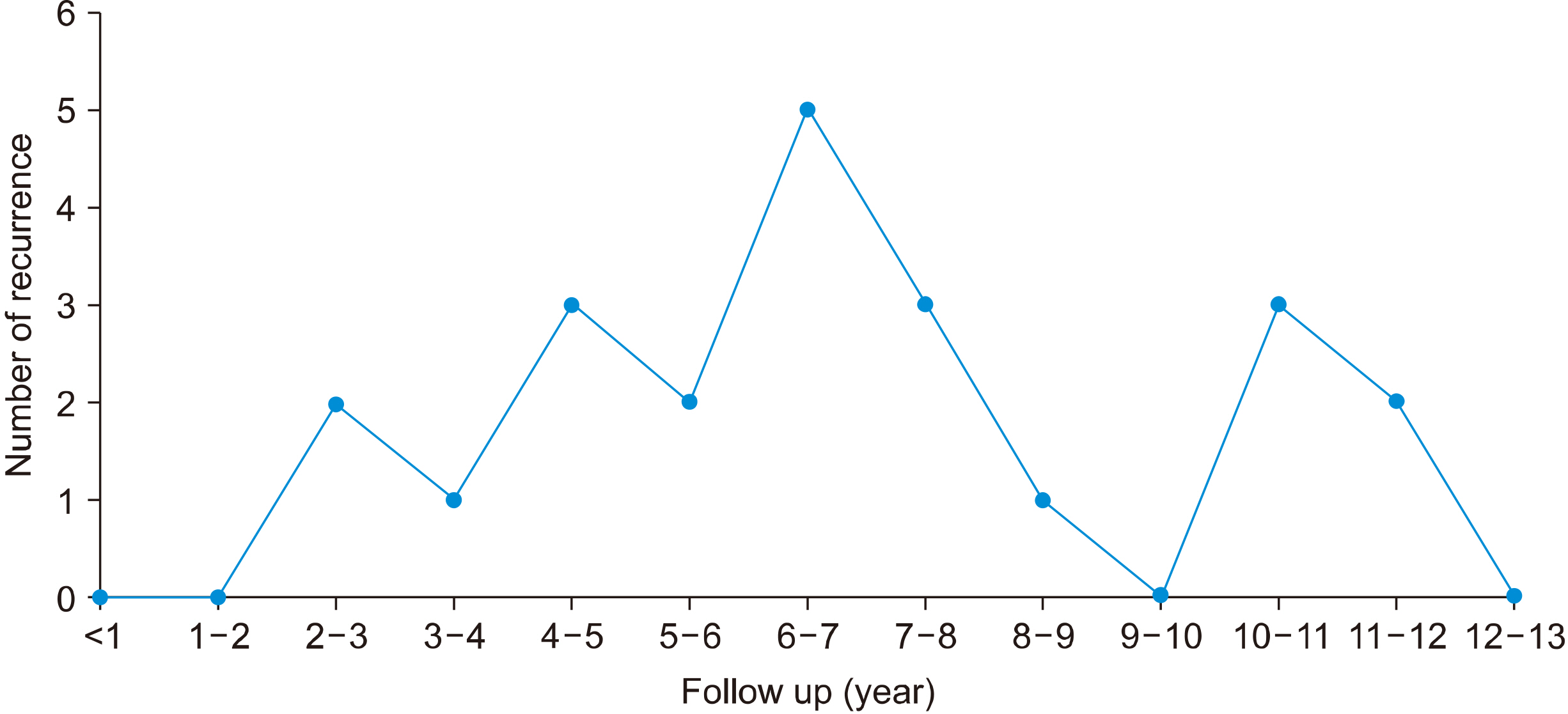1. Ito Y, Miyauchi A, Kihara M, Higashiyama T, Kobayashi K, Miya A. 2014; Patient age is significantly related to the progression of papillary microcarcinoma of the thyroid under observation. Thyroid. 24(1):27–34. DOI:
10.1089/thy.2013.0367. PMID:
24001104. PMCID:
PMC3887422.

2. Haugen BR, Alexander EK, Bible KC, Doherty GM, Mandel SJ, Nikiforov YE, et al. 2016; 2015 American Thyroid Association management guidelines for adult patients with thyroid nodules and differentiated thyroid cancer: the American Thyroid Association guidelines task force on thyroid nodules and differentiated thyroid cancer. Thyroid. 26(1):1–133. DOI:
10.1089/thy.2015.0020. PMID:
26462967. PMCID:
PMC4739132.
3. Kim DW. 2016; Long-term follow-up ultrasonography after lobectomy in papillary thyroid microcarcinoma patients: a single-center study. Endocr Res. 41(3):213–7. DOI:
10.3109/07435800.2015.1137583. PMID:
26864682.

4. Baek HJ, Kim DW, Lee CY, Huh JY, Sung JY, Choi YJ. 2017; Analysis of postoperative ultrasonography surveillance after hemi-thyroidectomy in patients with papillary thyroid microcarcinoma: a multicenter study. Endocr Pract. 23(7):794–802. DOI:
10.4158/EP161723.OR. PMID:
28448763.

5. Choi YS, Kim DW, Lee YJ, Ha TK, Jung SJ, Baek HJ. 2019; Appropriate neck ultrasonography surveillance during the first 10 years after hemithyroidectomy in papillary thyroid microcarcinoma patients: a single-center study. Ultrasound Q. 35(3):275–80. DOI:
10.1097/RUQ.0000000000000429. PMID:
30789488.

6. Piersanti M, Ezzat S, Asa SL. 2003; Controversies in papillary micro-carcinoma of the thyroid. Endocr Pathol. 14(3):183–91. DOI:
10.1007/s12022-003-0011-5. PMID:
14586064.

7. Davies L, Welch HG. 2006; Increasing incidence of thyroid cancer in the United States, 1973-2002. JAMA. 295(18):2164–7. DOI:
10.1001/jama.295.18.2164. PMID:
16684987.

8. Leenhardt L, Grosclaude P, Cherie-Challine L. Thyroid Cancer Committee. 2004; Increased incidence of thyroid carcinoma in France: a true epidemic or thyroid nodule management effects? Report from the French Thyroid Cancer Committee. Thyroid. 14(12):1056–60. DOI:
10.1089/thy.2004.14.1056. PMID:
15650358.

9. Perros P, Boelaert K, Colley S, Evans C, Evans RM, Gerrard Ba G, et al. 2014; Guidelines for the management of thyroid cancer. Clin Endocrinol (Oxf). 81 Suppl 1:1–122. DOI:
10.1111/cen.12515. PMID:
24989897.

10. Park YM, Lee DY, Oh KH, Cho JG, Baek SK, Kwon SY, et al. 2017; Clinical implications of pathologic factors after thyroid lobectomy in patients with papillary thyroid carcinoma. Oral Oncol. 75:1–5. DOI:
10.1016/j.oraloncology.2017.10.012. PMID:
29224804.

11. Lo CY, Chan WF, Lang BH, Lam KY, Wan KY. 2006; Papillary microcarcinoma: is there any difference between clinically overt and occult tumors? World J Surg. 30(5):759–66. DOI:
10.1007/s00268-005-0363-8. PMID:
16680591.

12. Roti E, Rossi R, Trasforini G, Bertelli F, Ambrosio MR, Busutti L, et al. 2006; Clinical and histological characteristics of papillary thyroid microcarcinoma: results of a retrospective study in 243 patients. J Clin Endocrinol Metab. 91(6):2171–8. DOI:
10.1210/jc.2005-2372. PMID:
16478817.

13. Ahn D, Lee GJ, Sohn JH, Jeon JH. 2020; Oncological impact of hypothyroidism and levothyroxine supplementation following hemithyroidectomy in patients with papillary thyroid carcinoma. Head Neck. 42(5):1004–13. DOI:
10.1002/hed.26075. PMID:
31930773.

14. Lee MC, Kim MJ, Choi HS, Cho SW, Lee GH, Park YJ, et al. 2019; Postoperative thyroid-stimulating hormone levels did not affect recurrence after thyroid lobectomy in patients with papillary thyroid cancer. Endocrinol Metab (Seoul). 34(2):150–7. DOI:
10.3803/EnM.2019.34.2.150. PMID:
31099202. PMCID:
PMC6599911.

15. Pisanu A, Reccia I, Nardello O, Uccheddu A. 2009; Risk factors for nodal metastasis and recurrence among patients with papillary thyroid microcarcinoma: differences in clinical relevance between nonincidental and incidental tumors. World J Surg. 33(3):460–8. DOI:
10.1007/s00268-008-9870-8. PMID:
19123022.

16. Huang H, Liu S, Xu Z, Ni S, Zhang Z, Wang X. 2017; Long-term outcome of thyroid lobectomy for unilateral multifocal papillary carcinoma. Medicine (Baltimore). 96(27):e7461. DOI:
10.1097/MD.0000000000007461. PMID:
28682915. PMCID:
PMC5502188.

17. Matsuzu K, Sugino K, Masudo K, Nagahama M, Kitagawa W, Shibuya H, et al. 2014; Thyroid lobectomy for papillary thyroid cancer: long-term follow-up study of 1,088 cases. World J Surg. 38(1):68–79. DOI:
10.1007/s00268-013-2224-1. PMID:
24081532.

18. Ito Y, Uruno T, Nakano K, Takamura Y, Miya A, Kobayashi K, et al. 2003; An observation trial without surgical treatment in patients with papillary microcarcinoma of the thyroid. Thyroid. 13(4):381–7. DOI:
10.1089/105072503321669875. PMID:
12804106.

19. Park S, Jeon MJ, Oh HS, Lee YM, Sung TY, Han M, et al. 2018; Changes in serum thyroglobulin levels after lobectomy in patients with low-risk papillary thyroid cancer. Thyroid. 28(8):997–1003. DOI:
10.1089/thy.2018.0046. PMID:
29845894.

20. Frates MC, Benson CB, Charboneau JW, Cibas ES, Clark OH, Coleman BG, et al. 2005; Management of thyroid nodules detected at US: society of radiologists in ultrasound consensus conference statement. Radiology. 237(3):794–800. DOI:
10.1148/radiol.2373050220. PMID:
16304103.

21. Park HK, Kim DW, Ha TK, Heo YJ, Baek JW, Lee YJ, et al. 2018; Utility of routine ultrasonography follow-up after total thyroidectomy in patients with papillary thyroid carcinoma: a single-center study. BMC Med Imaging. 18(1):12. DOI:
10.1186/s12880-018-0253-9. PMID:
29764382. PMCID:
PMC5952628.

22. Fukuoka O, Sugitani I, Ebina A, Toda K, Kawabata K, Yamada K. 2016; Natural history of asymptomatic papillary thyroid microcarcinoma: time-dependent changes in calcification and vascularity during active surveillance. World J Surg. 40(3):529–37. DOI:
10.1007/s00268-015-3349-1. PMID:
26581368.

23. Xia S, Dong Y, Kang H, Zhan W. 2018; Ultrasonography is valuable in evaluation of papillary thyroid microcarcinoma based on 5 mm tumor size. J Cancer Res Ther. 14(9):319–23. DOI:
10.4103/0973-1482.235347. PMID:
29970683.




 PDF
PDF Citation
Citation Print
Print




 XML Download
XML Download